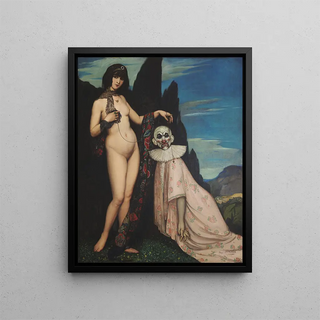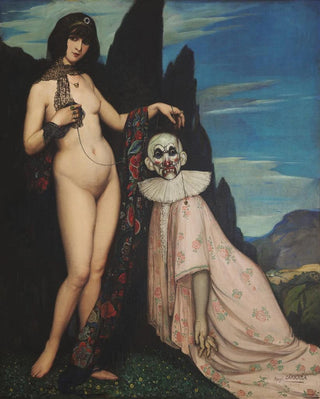Art print | The Woman and the Marionette - Ángel Zárraga


View from behind

Frame (optional)
In the vast panorama of early 20th-century Mexican art, the artwork "The Woman and the Marionette" by Ángel Zárraga stands out for its boldness and emotional depth. This canvas, which captures the essence of the human condition through the metaphor of the marionette, invites viewers to reflect on the links between control and freedom, manipulation and autonomy. The depiction of a woman, both vulnerable and powerful, evokes universal themes that still resonate today. Contemplating this piece transports one to a world where reality and dreams intertwine, where each brushstroke seems to tell a story.
Style and uniqueness of the artwork
Ángel Zárraga's style, characterized by a synthesis of modernism and Mexican pictorial traditions, is fully expressed in "The Woman and the Marionette." The vibrant colors and stylized forms create an atmosphere that is both dreamlike and unsettling. The artist skillfully plays with light and shadow to emphasize the emotions of his characters, making palpable the tension between the marionette and its manipulator. The use of the marionette as a symbol of manipulation invites reflection on human relationships, while subtly critiquing social norms. This artwork, through its composition and iconography, embodies a search for meaning and identity that transcends eras.
The artist and his influence
Ángel Zárraga, born in 1886 in Durango, is one of the emblematic figures of Mexican art. Trained in Paris, he managed to incorporate European influences while remaining deeply rooted in his cultural identity. His work is often marked by questioning the human condition, society, and spirituality. Zárraga was also a passionate defender of Mexican artistic traditions, seeking to reinterpret them through a modern lens. His influence is felt not only within the artistic circles of his time but also among subsequent generations of artists who see in him a model of innovation and creativity. Through "The Woman and the

Matte finish

View from behind

Frame (optional)
In the vast panorama of early 20th-century Mexican art, the artwork "The Woman and the Marionette" by Ángel Zárraga stands out for its boldness and emotional depth. This canvas, which captures the essence of the human condition through the metaphor of the marionette, invites viewers to reflect on the links between control and freedom, manipulation and autonomy. The depiction of a woman, both vulnerable and powerful, evokes universal themes that still resonate today. Contemplating this piece transports one to a world where reality and dreams intertwine, where each brushstroke seems to tell a story.
Style and uniqueness of the artwork
Ángel Zárraga's style, characterized by a synthesis of modernism and Mexican pictorial traditions, is fully expressed in "The Woman and the Marionette." The vibrant colors and stylized forms create an atmosphere that is both dreamlike and unsettling. The artist skillfully plays with light and shadow to emphasize the emotions of his characters, making palpable the tension between the marionette and its manipulator. The use of the marionette as a symbol of manipulation invites reflection on human relationships, while subtly critiquing social norms. This artwork, through its composition and iconography, embodies a search for meaning and identity that transcends eras.
The artist and his influence
Ángel Zárraga, born in 1886 in Durango, is one of the emblematic figures of Mexican art. Trained in Paris, he managed to incorporate European influences while remaining deeply rooted in his cultural identity. His work is often marked by questioning the human condition, society, and spirituality. Zárraga was also a passionate defender of Mexican artistic traditions, seeking to reinterpret them through a modern lens. His influence is felt not only within the artistic circles of his time but also among subsequent generations of artists who see in him a model of innovation and creativity. Through "The Woman and the






